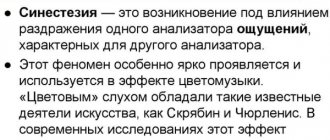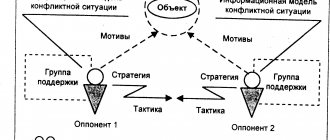The essence of the concept
Aggression is destructive behavior that is aimed at causing moral or physical pain to other people.
Such behavior contradicts existing norms and rules, and sometimes violates current legislation.
There are several ways to show aggression. One of these is verbal, that is, expressed using words . Achieving the goal occurs with the help of foul language, rude loud statements, insults, and accusations.
According to psychologists, verbal aggression is often displayed by spiritually weak people due to impotence, poor upbringing and lack of knowledge in the field of communication.
A type of verbal aggression is verbal violence. This is already a method of controlling another person through verbal means.
Usually found in relationships between husband and wife, parents and children, boss and subordinate. The peculiarity of violence is the inability of the other party to respond to the offender.
It is necessary to differentiate between verbal and linguistic violence. The latter is aimed at a certain class of people , for example, representatives of a certain nationality, age, etc.
Verbal violence has a specific victim .
The extreme manifestation of aggression is verbal humiliation.
It is represented by the behavior of an individual aimed at reducing the opponent’s self-esteem , as well as the decline of his reputation in the eyes of other people.
Treatment
What can be advised in these cases? Of course, don’t despair and deal with the problems. Psychologists or psychotherapists will help you with this.
As a rule, children and adolescents who are prone to verbalize their aggression are easy to talk to. The thing is that they are happy to communicate and be heard. Consequently, the correction of such manifestations occurs quite well.
Verbal aggression
Unfortunately, it occurs quite often in our society.
What is it? “aggression” speaks for itself. Aggression, whatever it may be, is a destructive, destructive phenomenon. The word “verbal” means that it is not explicit, but manifested psychologically, at the level of human communication. In general, verbal aggression
is the desire of one or more people to devalue and humiliate the feelings, achievements, dignity of another (others), condemnation and criticism, angry attacks against a weaker partner, refusal of moral support.
Causes
Some psychologists believe that aggression occurs in response to similar behavior of an opponent.
However, this is not quite true. For example, a child cannot respond in kind to a parent, just as a subordinate is forced to behave meekly with his boss for fear of losing his job.
The causes of verbal aggression are:
- A hostile attitude against the interlocutor that arose for objective or subjective reasons.
- Provocative actions of the opponent.
- The behavior of the interlocutor, contrary to the norms of the law and society, is perceived as inadequate.
- The desire to attract attention to oneself.
- The desire to establish authority by humiliating others.
- A low level of development in which a person cannot communicate without aggression.
- A manifestation of spiritual impotence, when an individual is simply unable to convey information in a different way.
In all cases, a person has one motive - to bring suffering to another . This is expressed not only in external factors, but also in the internal message.
For example, some people use foul language without being aggressive. Their interlocutor perceives such communication normally and is not at all offended. This is due to the absence of malicious intent in inflicting pain.
Based on the above, it is possible to determine the personality type of an aggressive person. People most often display aggression:
- Spiritually immature.
- Poorly brought up.
- Experiencing humiliation in childhood.
- Poorly educated.
That is, among such individuals, the majority are addicted to alcohol, drugs, and brought up in dysfunctional families or orphanages. Such behavior is a desire to hide your low self-esteem.
Also, regular aggression can be a sign of mental illness . In educated and well-mannered people, outbursts of aggressive behavior are usually a method of response to negative behavior towards them or violation of social norms by other people.
Speech aggression - consultation for other psychologists
"Speech aggression in children"
What forms of aggression can a child exhibit in preschool age? In psychology, it is customary to distinguish various forms of aggression that can manifest themselves in a child already in preschool age:
- Physical aggression –
these are actions against someone using physical force (fight);
- Verbal aggression
(swearing, threats, shouting, etc.).
- Irritation
(hot temper for any reason, rudeness towards others);
- Indirect aggression
.
It can be of two types: a) Directed aggression
is expressed in gossip or malicious jokes;
b) Undirected aggression
can be expressed in shouting in the surrounding society, stomping. - Negativism
- this is behavior in which any actions of others will
- Resentment,
oddly enough, this is also a manifestation of aggression;
- Suspicion and caution
in everything;
- The child may experience guilt
for no apparent reason.
Speech aggression
Aggressive behavior already in preschool age takes various forms. Most often, children display physical and verbal (verbal) aggression.
Verbal aggression -
This is a manifestation of rudeness in a child’s speech, negative speech influence, offensive communication with people around him, a very clear expression of negative emotions and intentions in an offensive form.
Psychologists identify several types of verbal aggression:
- Indirect verbal aggression
– it is aimed at blaming or threatening an adult, a peer, and so on. This type of aggression manifests itself in a variety of statements in the form of complaints against the offender (sometimes fictitious complaints), demonstrative screaming (in order to pay attention and carry out the will), aggressive fantasies (which the child talks about).
- Direct verbal aggression
– these are insults and verbal forms of humiliation of another (insults, “bullying”, teasing).
What types of statements can represent a child’s verbal aggression?
Types of aggressive statements :
Manifested in the fact that the child uses words and expressions that contain offensive characteristics of the addressee. When insulting someone, preschoolers most often reproduce the statements of their elders and copy the aggressive behavior of other people. Insults in the speech of children of senior preschool age are already more meaningful and purposeful. Insults are used mainly when communicating with peers and younger people, somewhat less often - used in relation to elders, much less often - arise in conflict interactions with adults, especially “step-children” (educators, teachers, passers-by on the street, etc.). The basis of children's insults are words mainly associated with the concepts of “mental illness” (for example, “sick”, “crazy”, “crazy”, “escaped from a mental hospital”, “lost the roof”, etc.). It is children's insults that are often based on various kinds of derogatory understatements - age, height, status in the peer group, etc.
Hostile remarks are negative judgments about an interlocutor and an expression of a negative attitude towards his qualities, actions, and personality as a whole. These comments come down to a verbal designation of the child’s aggressive position. Hostile remarks are always in the form of complete sentences, and never exist as isolated words or phrases. Parents should distinguish between harmless nicknames that are common in almost any children's company and form an important part of children's communication culture: neutral ones, for example, derivatives of given names, surnames, and so on. But here, too, there is one “BUT”: if the child’s nickname clearly offends, causes a reaction of rejection, discomfort, aggression, then in this case it is classified as an intentional insult. Ridicule - a caustic remark, causticity, mockery - this is how ridicule is defined. In the communication of young children, teasing is not always and not all of an unambiguously aggressive nature. One of the important functions of teasers is to establish norms of behavior in the group and suppress deviations from them (teasers against sneaks, greedy people, etc.). However, teasing is most significant as a way of testing the “social strength” of a group member, especially a newcomer, and his ability to stand up for himself.”
Rough requirement
It embodies the child’s intention to get rid of the addressee or somehow influence him, force him to perform some action in his own interests. In rude children's demands, the verbs “go” predominate. “Referential” phrases are also used. Older preschoolers are characterized by sophisticated verbal forms of rough demands that are playful in nature.
Aggressive protest, objection, refusal
The child does not use polite refusals or polite expressions of disagreement in his speech. Aggressive forms of speech differ from acceptable forms of communication in that:
- there are no necessary politeness formulas - “sorry”, “please”;
- the child uses aggressive intonation in his speech - a rude, raised, harsh, hostile tone;
- the child does not explain the reasons for refusal
These aggressive statements are limited to children's environments and are almost never used in communication with adults. Children's threats are always characterized by promises of some action from third parties. Reproach, accusation
Children reproach or blame adults or their friends for the current situation. They do not see and do not admit their guilt.
The complaint implies that there will be a “redirection of punishment” to a more influential person. Preschoolers often resort primarily to overt verbal aggression and are much less likely to show it in a hidden, veiled manner. Children's speech aggression can be directed directly at the interlocutor - transitive-displaced, indirect - intransitive. Depending on the object of children's verbal aggression: more often it is directed at peers or younger people and less often at older adults. The main reason is the fear of reproach and punishment, of deprivation of something significant. It is in the children's environment that verbal aggression often takes group, collective forms. Psychologists define such actions as mobbing (from the English mob - crowd) - bullying one person by several. Aggression in a children's group is always recognizable by characteristic words such as “declare a boycott”, “make fun of”, “start a dark” or other expressions. Sometimes gossip occurs. Several types of children's responses to verbal aggression can be distinguished:
- Retaliatory verbal aggression is the most typical reaction of a child to a verbal attack by an “aggressor”—a peer and younger in age;
- Complaint - implies a message about the offender - to the teacher, parents, friends, older children;
- Game methods are the so-called “excuses”, responses to “teasers”: “returning” the insult;
- Transitive (push, hit) and intransitive physical aggression (damage the clothes, toy of the “offender”; put in an awkward, comical position - put a button, pour glue into a pencil case, move a chair).
Yu.V. Shcherbinina offers a playful classification of the most striking types of speech behavior of little “aggressors”, the basis of which was the plot of A. K. Tolstoy’s fairy-tale story “The Golden Key, or the Adventures of Pinocchio”, which find a place in everyday life:
- Harlequin
– teases, calls names, bullies, often threatens children.
- Pierrot
– whiny, always offended, reproaches others, is not an aggressor, defends himself from others. Claims that he is “special” and exceptional, often “revels” in the role of the victim and likes it. Often fantasizes about grievances.
- Pinocchio
- uses situational verbal aggression, tolerates parental upbringing, but often breaks down.
Reasons for the manifestation of aggression in children's speech
The causes of speech aggression can be very different: from upbringing errors to personality disorders. Speech aggression in early preschool age can arise as an unconscious imitation of the behavior of adults, “like an adult.”
In older preschool age, as a rule, verbal aggression is a child’s protest against the direct or indirect violence of adults, which is expressed in an authoritarian approach, pressure on children, derogatory statements addressed to them, and unwillingness to take into account their interests and opinions.
Speech aggression in children is an acute problem for teachers, parents and psychologists. Yu.V. Shcherbinina identifies types of aggressive speech behavior in children :
- A child’s aggressiveness takes on the character of a stable personality trait and forms such attitudes, patterns, and tendencies of speech behavior that can be generally defined as an orientation towards verbal attack (the most offensive insults, obvious threats, direct accusations, caustic ridicule) with the intention of causing communicative harm.
- Verbal aggression is predominantly a reactive outburst of negative experiences, a spontaneous discharge, a defensive reaction to trouble, some external irritant, the same rudeness (sneaking, rude refusals, protests).
Aggression is a complex phenomenon. Psychologists identify several main approaches that explain the nature of the emergence of child and human aggression in general:
- Biological
-
defines aggression as an innate quality; - Social
– considers aggression as an acquired situational behavior in the process of social adaptation.
All theories existing in psychology recognize that aggression is an integral characteristic of human activity and adaptability. Psychologists also note that the following can be considered a prerequisite for children to display verbal aggression :
- Psychological crises of development. They are characterized by high excitability, conflict behavior, and unstable mood. Changes occur in the attitude towards the world around us, all people, and our “I”. All these transformations are reflected in the child’s speech;
- Limited physical capabilities of the child, imperfect motor skills, lack of necessary life experience (they cannot dress themselves, tie their shoelaces, or explain to an adult what they need);
- The child may have a need for self-affirmation, self-realization, self-defense, and he will realize them through verbal aggression;
- Verbal aggression can be provoked by a pathological speech environment in which the child communicates (family, yard, etc.);
- Propaganda of certain forms of aggressive interaction in modern media, primarily on television, the Internet and computer games;
- An accelerated pace of life, when the child and parents are constantly under stress.
Most children in preschool age show a tendency towards verbal aggression, and in some children this form of behavior becomes permanent, persists and develops, becoming a stable personality quality.
Adults who are close to children are required to constantly work on themselves, self-control of speech, behavior, and actions. It is important to change your view of the child, to see in him not an object for education, but a subject - an individual with his own rights; create conditions that ensure the psychological safety of the child’s personality.
Research in the field of psychology shows that controlling aggression in the speech of preschool children is especially important, since this tendency is in its infancy and timely measures can still be taken to prevent and correct behavior.
Forming the ability to control the aggression of words, improving the skills of effective communication, which does not allow rudeness, lack of contact, and hostility, is the most important moment in raising a child at the stage of preschool childhood.
Work with children to correct verbal aggression may include the following areas:
- Teachers need to pay special attention to the development of children’s speech activity and direct it in a positive direction.
- Create a positive microclimate in each group: an emotionally positive atmosphere of acceptance of each child, creative search, and a common joyful experience of the successes of all children.
- Use surprise moments, methods, techniques aimed at relieving psycho-emotional stress (elements of psycho-gymnastics, art therapy, breathing and finger exercises, moments of pranks and silence, figurative role-playing games);
- Create a cult of correct literary speech in the group;
- Monitor the well-being and mood of all children in your group using individual conversations - analyzes “What makes me happy, what upsets me in kindergarten”, “How was your day in kindergarten”.
- Teach children to self-analyze their actions.
- Include socio-game methods and techniques in the educational process: interaction of children in pairs, triplets, groups.
- Expand the social circle of children by inviting guests to the group, visiting neighboring groups, different rooms of the kindergarten in order to interact with other children and employees.
- Develop children's dialogical speech through specially designed communication situations. Use problematic questions, problematic situations that encourage children to discuss.
- Orient children to get to know another person (peer, adult), develop the ability to understand his interests, mood, and emotional manifestations. Teach children the ability to correlate their own feelings and desires with the capabilities and desires of others.
- To teach children the ability to resolve controversial issues and resolve conflicts with the help of speech: to convince, prove, explain.
- Remind children of verbal politeness formulas. Encourage children to try to express their opinions and use words in strict accordance with their meaning.
Thus, a positive example of an adult (control, tact, speech culture, use of forms of politeness), a friendly, caring attitude towards the child as a subject of the educational process, preservation of physical and mental health - this is the guarantee that verbal aggression will disappear from the behavior of our children.
Classification
The individual uses the following methods of expressing an aggressive mood:
- insults;
- accusations;
- obscene words;
- rude talk;
- threats, curses;
- evil banter;
- slanderous talk;
- criticism without reason;
- screams, tears, negative sounds.
However, angry words or obscene expressions themselves cannot be a sign of aggressive behavior if they do not have an emotional message, that is, they are not combined with nonverbal signs, such as:
- gesturing (clenched fist, waving hand);
- facial expressions (angry facial expression);
- body position (offensive, towering);
- intonation (loud voice);
- invasion of someone else's personal space.
Verbal aggression can be divided into the following types:
- Direct active . Insults and humiliations are manifested directly during the conversation between the interlocutors.
- Indirect active . The aggressor spreads gossip and slanders the person behind his back.
- Direct passive . The individual refuses to talk and communicate with the person.
- Indirect passive. It is expressed by refusal to defend the undeservedly offended, to testify in his favor.
While direct aggression is easy to recognize, hidden aggression is not always detected .
Since the offender in direct communication can be friendly and polite.
Forms of hidden aggressive behavior are:
- Condemnation, criticism . The aggressor constantly criticizes the interlocutor under the guise of a desire to help. And he praises in such a way that his praise plays against his opponent.
- Jokes .
The individual constantly makes jokes and presents it as just fun. However, he does this in front of other people, and not in private, which indicates his malicious intent. - Controversy . No matter what the interlocutor says, the aggressor will always oppose his opinion.
- Disparagement of merit . Even if a person has been awarded high awards, the aggressor will constantly claim that it was very easy and the award was received undeservedly or “through connections.”
Types
What exactly is verbal aggression? In fact, this is one of ten types of experimentally identified variants of verbal attacks, which can be as follows:
Why are nonverbal signs included in the layer of verbal aggression? Yes, because with their help expressions and turns take on completely different, offensive forms. We include the following signs:
- gestures (clenched fists, crossed or resting hands on the sides);
- facial expressions (angry or disdainful facial expression);
- poses (“imperative poses” are always perceived as a provocation);
- visual contact (a gaze that is perceived as “impudent” can be provocative here);
- intonation and timbre of the voice (even a phrase that is harmless in meaning can be shouted or said with disdain, provoking offense);
- organization of time and space of communication (invasion without demand into “foreign territory” or an urgent challenge to one’s own, realizing that in such a place communication will be uncomfortable, is already regarded as an act of attack).
“Do you think this is true?” says the parent or leader. In fact, this phrase is not offensive. But, if you add a certain posture, timbre of voice, put your hands on your hips, and even call your interlocutor “to the office on the carpet to the authorities.” A harmless phrase immediately becomes a threat, a condemnation of opinions and attitudes. And the phrase: “Everything is clear with you, my dear,” with certain non-verbal “additions” calls into question the level of mental abilities and competence. In a word, both in the first and second cases cause internal discomfort and worries.
After verbal aggression, physical aggression can be provoked. This happens if there is an initial disposition of the object of aggression due to its characteristics: personal, social or situational. Personal characteristics most often include age and gender. Social factors include ethnicity, social well-being of the environment, level of education and general culture.
Situational factors most often include the environment, the physical, physiological and neuro-emotional state of a person and additional factors that may influence the adequacy of the assessment and perception of the situation. But we should not write off the influence of social factors. These factors are determined by the national mentality and the division of certain linguistic norms as “unacceptable” or “acceptable”. Thus, in some ethnic groups it may be absolutely unacceptable to make offensive statements about the interlocutor’s parents. And such things always provoke an act of physical aggression. Whereas in another group it will not cause such a violent reaction.
Verbal aggression can take the form of direct aggression, which is carried out directly on someone here and now. Or maybe indirect. Indirect verbal aggression is heterogeneous and includes two different but complementary concepts. In the first case, it is considered as aggressive behavior, the focus of which on a specific person is hidden. In the second case, it is considered as aggression, which in a roundabout way seeks to hurt the victim. In fact, these two concepts are similar in principle of action - without direct statement. It has the appearance of intrigue and gossip. Insult is achieved by damaging, first of all, a person’s reputation.
Aggression in children and adolescents
Very often, children and adolescents demonstrate aggressive behavior.
This is associated with the formation of personality, the desire to establish themselves and earn authority among their peers.
A young child initially displays aggression as an expression of his resentment and emotions. At the same time, he evaluates the result of such behavior.
If he managed to achieve his goal once, he will demonstrate this behavior constantly to get a toy, ice cream, etc.
At a young age, children express aggression by screaming, crying, and hysterics. Schoolchildren already know how to control their behavior, so their actions are purposeful.
The child calls names and makes fun of his peers. Girls usually gossip and give nicknames to others. Such children usually have low self-esteem and poor relationships with their parents .
Teenagers act more sophisticatedly: they insult, humiliate, and force them to obey. They often drive the victim to suicide.
The main provoking factors of aggressive communication in children are:
- Family relationships. Children observe violence among relatives and imitate their parents. Children often become aggressive when they themselves are humiliated by older relatives.
- Features of the nervous system. If a child has some kind of neurological disease, he does not tolerate the load well and cannot withstand psychological discomfort.
- External influences. An attack of aggression can be caused by a bad grade, a remark from a teacher, fatigue, or a heavy academic load.
Danger
Aggressive behavior contradicts not only moral principles , but also legal norms. It can be dangerous for both the offender and the victim.
If the victim responds with similar manifestations, this may turn into physical confrontation, namely beatings, bodily harm, or murder.
For the victim, verbal aggression is dangerous because the person constantly feels humiliated, loses self-esteem and can lead to suicidal thoughts .
A person can also get used to humiliation and perceive it as the norm.
This happens to a child who is constantly suppressed and scolded by his parents.
Having matured, such a person will tolerate negativity from other offenders.
In children, behavioral skills develop into personality traits over time. This leads to the development of psychopathy against a background of aggression. The likelihood of deviant behavior, maladjustment in society , and the commission of crimes also increases.









